The Big One: How KING KONG Became The First Post-JAWS Blockbuster
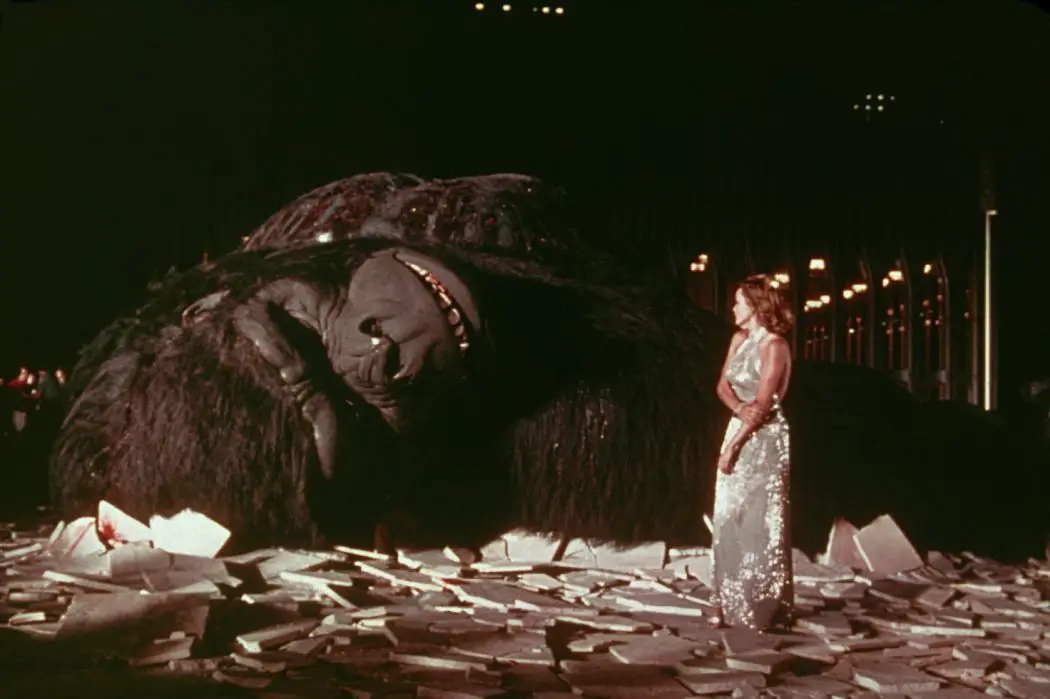
Lapsed scriptwriter and dad, currently failing to encourage my children…
It’s been just over ten years since King Kong last put in an appearance, in Peter Jackson’s $200m ode to the 1933 movie that made him want to become a director in the first place. The result was a sizeable hit, hamstrung by one of the biggest budget-cheques ever signed, and by a three hour plus running time that tested the patience of many. The King’s latest project, Kong: Skull Island, however, seems to be imbued more with the spirit of a different hairy ancestor, one who shares his upright, humanoid countenance, and his funky 1970s setting.
Back in 1976, John Guillermin’s King Kong was written off as a flop on first release, and the whiff of failure has clung to it for forty years. Jackson’s epic was meant to have wiped its sorry existence from the memory forever. In 2005, Empire magazine described it as ‘a bloated carcass in the elephant’s graveyard of ’70s spectacular cinema.’ Twelve years later, for all its great strengths and undeniable high-points, King Kong (2005) is rarely remembered and revisited (who’d have the time?), its wall-to-wall CGI effects having become just that little bit less impressive with each passing year. Time has, conversely and not without a sense of mischief, conferred onto Kong ’76 something which no amount of money can buy – charm.
Kong vs Kong
There were two main reasons for Kong ’76’s initial disappointment and both were self inflicted gunshots. Producer Dino De Laurentiis, spurred on by the gargantuan success of Jaws the previous year, had determined to top Spielberg’s mechanical shark with a fully-automated 40 foot high King Kong, capable of walking, climbing, expressing emotions and ripping trains apart like they were made of cardboard.
Overlooking the fact that Bruce the Shark was such a notoriously unreliable prop that Spielberg had to use POV shots for most of the movie to compensate for his non-functioning rubber beast – to the enormous benefit of the finished film – to any reasonable special effects man, this sounded like utter madness. Nonetheless, De Laurentiis pressed on and Carlo Rambaldi (E.T.’s future designer) was commissioned to construct the greatest special effect ever built.
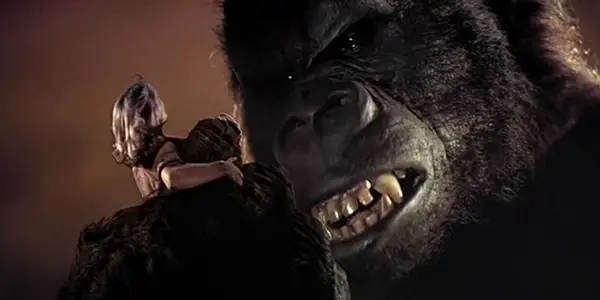
De Laurentiis then took his mechanical Kong on tour to drum up publicity, where the slow jerky hydraulic hand movements, robotic facial expressions, and occasional malfunctions – at one point, a hydraulic pipe in the Kong’s crotch burst and Guillermin was heard screaming, ‘He’s peeing oil!’ – made it clear to everyone that a plan-B was required, namely a man in an expensive ape costume. As such, the much-ballyhooed robotic King Kong as promised by Dino de Laurentiis, was visible for less than a minute (in the grand unveiling scene in New York) – which amounted to around $28,000 a second – and furthermore bore practically no resemblance to the Kong costume on display for the previous hour. If anything, it looked like an enormous Kenner Hoth Wompa toy, covered in glue and rolled in dog-hair.
This bitter let-down compounded the disappointment felt by moviegoers, who for a whole year had been tantalised by John Berkey’s extraordinary poster depicting Kong in broad daylight atop the newly-built World Trade Center, so gargantuan that he straddles both towers, crushing a fighter jet in his paw while others fly around him. In reality, a considerably smaller Kong fought off helicopter gunships and at night too – “I hated the fact that the ending was done at night-time,” remembered Peter Jackson, “They were cheating.” The poster’s claim that this would be ‘The most exciting original motion picture event of all time’ too, might have been something of an overreach.
Special effects genius Rick Baker (An American Werewolf in London), who was charged with playing the title character, said “King Kong offered the one chance to do a really perfect gorilla suit. With the money and the time, it could have been outstanding. Unfortunately, it wasn’t. There were compromises and enforced deadlines.” These compromises and deadlines were the result of backstage legal shenanigans that turned the Kong production schedule into a mad dash for a finishing line in the form of a ridiculously close release date; perfection be damned.
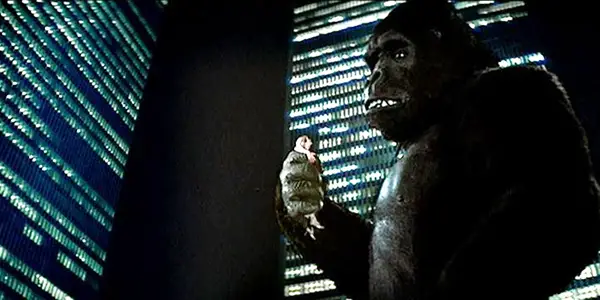
It wasn’t just De Laurentiis who had plans to remake King Kong in the 1970s. There was the indescribably delicious prospect of a Hammer remake using stop-motion animation – they did shoot test footage, which was eventually used as a Volkswagen advert! De Laurentiis had paid RKO $200,000 for the rights to King Kong so as far as he was concerned, there was only one King Kong – his, which Paramount now had the deal to distribute. This came as news to Universal Studios who believed that they had a verbal agreement with RKO to shoot their own remake, The Legend of King Kong.
It was suddenly a legal matter but rather than backing off, both sides instead went into overdrive. Universal cobbled together a production crew and hired Joseph Sargent (The Taking of Pelham One-Tw0-Three) to direct Bo Goldman’s screenplay, even taking out an ad in January 1976 to announce that production had already started on ‘Legend.’
De Laurentiis had the upper hand, having at least secured a contract and an actual signature, but he played hardball and sent John Guillermin and his cast and crew off to Shanghai to get as much footage in the can as possible. There was also the bold claim on the poster, first unveiled on November 30th 1975, that King Kong would be released ‘One year from today.’ This locked them into a production schedule that would have been seen as a bit of a rush if it were a low-budget romantic comedy starring Dean Jones. The curtain only came down on this legal ballet months before the film’s release, with Universal being paid off with a cut of De Laurentiis’s grosses.
Final Analysis
Under such tight, hectic circumstances, it’s a miracle that anything amounting to a watchable film emerged at all. The initial disappointments; the feeling on its opening weekend that the audience had been cheated, were perfectly understandable, but 40 years later it’s easier to assess the film on its own merits, and there are many. It is a vast, screen-filling film, rich with genuinely memorable moments – the eerie scene when a dancing islander stops still when he spies Jeff Bridges and his friends; the haunting, hushed shot of Kong’s paw lifting up out of the ether in his tranquilizer trap, and Jessica Lange’s sacrifice, built up to a rising cacophony of John Barry brass and falling trees before revealing the title character in uncharacteristic silence.
Dino De Laurentiis didn’t just hurl money at the special effects budget, he chose his collaborators well, especially his composer. Barry’s score is one of his finest, an unforgettably vast, bombastic symphony with an aching heart at its centre. Richard H. Kline’s rich Panavision cinematography is bold and sumptuous, especially in the scenes on Skull Island.
It is a judiciously cast film too – as opposed to Jackson’s version which bet too heavily on Adrien Brody’s leading man status and overestimated Jack Black’s ability to play it straight. Jeff Bridges, fresh from his Oscar-nominated turns in The Last Picture Show and Thunderbolt and Lightfoot, was a hip, sympathetic, credible romantic lead (wearing a beard that only Jeff Bridges could make desirable). Charles Grodin – as he always, always does – steals the show as the jumped-up, ruthlessly ambitious company man, by turns giddy with the prospect of untold riches and thwarted by the increasingly fantastic obstacles that fall into his path.
Shrewd casting saw smaller roles played by some of the best character actors in the business, like Ed Lauter, John Randolph, John Lone and Julius Harris. However, all eyes were on the girl in Kong’s grip. King Kong had made Fay Wray a movie icon, and there was fevered speculation as to who would replace her in the remake. Barbara Streisand was mentioned, as was Valerie Perrine, Britt Ekland, Kim Basinger and Meryl Streep – Streep revealed recently that De Laurentiis had dismissed her unchivalrously as not attractive enough (Meryl Streep!) in Italian, not realising that Streep spoke the language fluently.
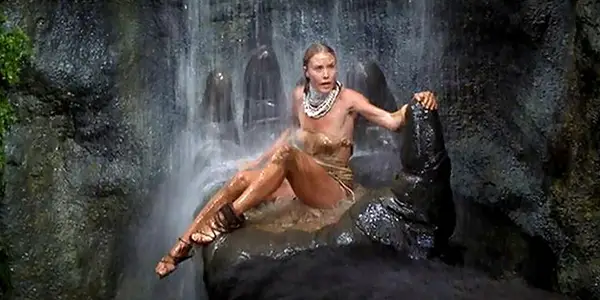
Eventually, Jessica Lange was cast in her first movie. Luminescent and off-puttingly beautiful, she struggles heroically to overcome some of the most inane dialogue in the film – “Put me down you male chauvinist pig ape!” – but still radiates the kind of unfakeable screen magnetism that would later make her such a major star. The critics who dismissed her unfairly in King Kong – Harry and Michael Medved wrote her off as ‘an inept fashion model with no previous acting experience.’ – would have to eat humble pie six years later when she won her first Oscar for Tootsie.
That dialogue, by Lorenzo Semple Jr, is part of the push & pull dynamic at the heart of King Kong, and might even be a key to its unexpected durability. Semple, a fine scriptwriter responsible for some genuine 1970s classics (Papillon, Three Days of The Condor, The Parallax View) was pathologically unable to take pop culture seriously and invariably adopted a high-camp, knowing tone in Kong, later Flash Gordon and most famously in the 1960s Batman TV series of which he was one of the key architects.
In contrast, Guillermin wanted to make a genuine, heartfelt fantasy romance. When Ingmar Bergman visited the set with his wife and asked Guillermin what kind of film King Kong was going to be, he just said, “Romantic.” Miffed at the way the kudos for his previous film, 1974’s mega-hit The Towering Inferno had been transferred to producer Irwin Allen, Guillermin was determined to make the defining romantic fantasy of the decade. This combination of Guillermin’s sincerity and Semple’s rampant insincerity doesn’t always work but it gives the film a ying/yang personality that is often found in great collaborative works. (Sadly for Guillermin, the publicity machine ensured that as far as the world was concerned, this was ‘Dino De Laurentiis’s King Kong.’)
Kong’s Legacy
King Kong was the first post-Jaws blockbuster: a mega-grossing epic from its inception onwards. Jaws had restrung the finishing-ribbon of commercial possibility so far down the track, that the rewards were now potentially limitless. Dino De Laurentiis followed Universal’s Jaws marketing campaign to the letter. By the end of 1976, Kong-mania was a fully-fledged pop phenomenon. “De Laurentiis negotiated marketing tie-ins with Jim Beam Distilling, 7-Eleven, GAF, Sedgefield Sportswear, Schrafft Candy and several other companies whose products were emblazoned with high-profile ape imagery.” The film imitated Jaws’s mass-saturation opening strategy (961 cinemas). Unlike with Jaws, however, the buzz dried up quickly and the final domestic gross topped out at $90 million, which would have been enormous had De Laurentiis not publicly predicted that it would become the first $200 million grosser.
“Crucially, $35 million of that final gross was earned in the first seventeen days of release, after which ticket sales plummeted….The saturation release led to front-loaded grosses that ensured the film would perform relatively well, regardless of word-of-mouth.” After Jaws, King Kong was the first movie to deliberately utilise this mass-opening strategy, the complete flip side of perceived Hollywood marketing wisdom at the time. Little has changed since.
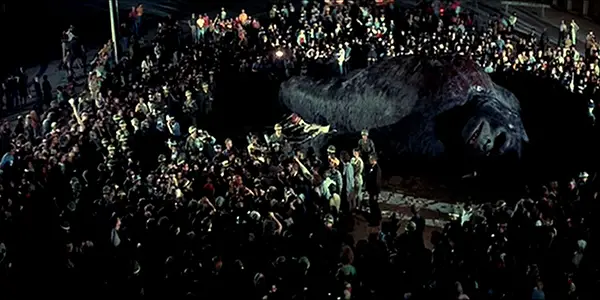
It was on television, over repeated showings, that King Kong acquired a new young audience who subsequently grew up with the film – in a bit of a coup, De Laurentiis was paid $19.5 million by NBC to broadcast King Kong twice (in a rather gratuitously padded-out three hour version) – and TV became its natural home for the next three decades. Over time, its very 1970s-ness has become part of its unique charms. Viewed now, free of the hollow promises of a showman producer whose imagination proved to be thirty years ahead of Hollywood’s technological capacity, the very real limitations of 1976-era special effects only add to the enjoyment, in much the same way that the crimson, viscous Kensington gore which, spilt over so many British horror movies of the 1960s, now provides such reassuring comfort to horror movie connoisseurs.
It is worth mentioning too that, though the film was quickly written off as a flop, it had some high-profile champions: Pauline Kael said that it was ‘a pop classic that can stand in our affections right next to the original version,’ and Variety called it ‘one of the most fabulously successful remakes in the brief history of motion pictures!’
I tend to think of Kong ’76 in the same apologist way that I consider Moonraker (another film in which the lead character engages in a fight to the death with a wholly unconvincing rubber snake): it’s a bloated, well-meaning but ultimately rather empty spectacle that only ever meant to entertain and having done so, many times over the years, finally deserves a break. Like the man said, “Here’s to the big one.”
Your Turn.
Are there any other notorious heroic failures that you feel have earned the right to a retrial? Howard The Duck, maybe? Superman III? Orca…Killer Whale? Ishtar? What about King Kong Lives? Good on you if you can find any redeeming qualities there, but all underdogs deserve a champion. The comments box is yours to fill…
Sources:
The Making of Dino De Laurentiis’s King Kong. Cinema Retro, issues 32 & 33.
The Creation of Dino De Laurentiis’s King Kong by Bruce Bahrenburg.
Empire Magazine, January 2006.
Lost Illusions: American Cinema in The Shadow of Watergate and Vietnam by Da vid A Cook
Escape Velocity: American Science Fiction Film, 1950-1982 by Bradley Schauer
The Golden Turkey Awards by Harry and Michael Medved.
Does content like this matter to you?
Become a Member and support film journalism. Unlock access to all of Film Inquiry`s great articles. Join a community of like-minded readers who are passionate about cinema - get access to our private members Network, give back to independent filmmakers, and more.
Lapsed scriptwriter and dad, currently failing to encourage my children to watch black and white films. Alter-ego: a mild-mannered restaurateur in north Wales. Have been writing about films and food for three years in magazines like Cinema Retro and The Chap, and on websites like HeyUGuys.com and Taste of Cinema. Obsessed by cinema in all its forms.













